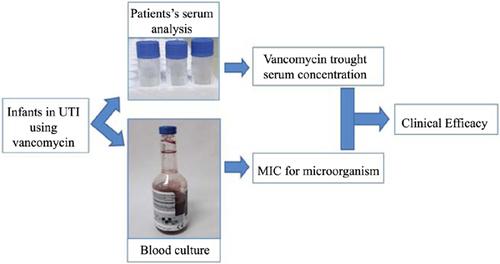Current Pharmaceutical Biotechnology ( IF 2.8 ) Pub Date : 2020-08-31 , DOI: 10.2174/1389201021666200327162402 Nadielle S Bidu 1 , Bruno J D Fernandes 2 , Jucelino N C Filho 1 , Regina E A Bastos 3 , Joice N R Pedreira 1 , Ricardo D Couto 1

|
Background: Vancomycin is the first-line antibiotic used for the treatment of staphylococcal infections. Because of its narrow therapeutic window and the pharmacokinetics variability, vancomycin trough serum concentration should be monitored. However, due to the increased cases of staphylococcus’ commensal species infections and the case of vancomycin resistance, the minimal inhibitory concentration should be considered on antimicrobial therapy.
Objective: This article aimed to show the importance of the minimal inhibitory concentration to infants on vancomycin therapy as regular criteria.
Materials and Methods: Three infants in the use of vancomycin, hospitalized in the same maternity hospital, and that had at least one blood culture performed during the intensive-care-unit hospitalization were included in the study. Vancomycin serum concentrations were determined by particleenhanced- turbidimetric inhibition-immunoassay. The vancomycin minimal inhibitory concentration data were interpreted by following the Clinical and Laboratory Standards Institute (CLSI) and the European Committee on Antimicrobial Susceptibility Testing (EUCAST). The trough serum concentration range of 10 to 20 mg.L-1 was considered therapeutic.
Results: All three patients had at least one infection by S. epidermidis, being one patient exhibit vancomycin- resistant S. epidermidis infection. All patients had stoppages in the vancomycin treatment, and the minimal inhibitory concentration was performed for only one patient.
Conclusion: The data obtained from these patients also showed the need to perform therapeutic monitoring by using minimal inhibitory concentration values, because, although the serum concentrations were within the reference range, they are insufficient to guarantee patient therapeutic success.
中文翻译:

万古霉素最低抑菌浓度是否应作为婴儿重症监护常规标准使用?
背景:万古霉素是用于治疗葡萄球菌感染的一线抗生素。由于其狭窄的治疗窗口和药代动力学变异性,应监测万古霉素谷的血清浓度。然而,由于葡萄球菌共生菌感染病例的增加和万古霉素耐药的情况,在抗菌治疗中应考虑最低抑菌浓度。
目的:本文旨在显示万古霉素治疗对婴儿的最小抑菌浓度的重要性,作为常规标准。
材料和方法:研究对象包括三名使用万古霉素的婴儿,它们在同一家妇产医院住院,并且在重症监护病房住院期间至少进行了一次血液培养。通过颗粒比浊抑制-免疫测定法测定万古霉素血清浓度。根据临床和实验室标准协会(CLSI)和欧洲抗菌药物敏感性测试委员会(EUCAST)解释了万古霉素的最低抑菌浓度数据。低谷血清浓度范围为10至20 mg.L-1被认为具有治疗作用。
结果:三名患者至少有1名被表皮葡萄球菌感染,其中1名患者表现出耐万古霉素的表皮葡萄球菌感染。所有患者在万古霉素治疗中均停药,仅对一名患者进行了最低抑菌浓度。
结论:从这些患者获得的数据还表明,需要使用最小抑制浓度值进行治疗监测,因为尽管血清浓度在参考范围内,但不足以保证患者治疗成功。



























 京公网安备 11010802027423号
京公网安备 11010802027423号